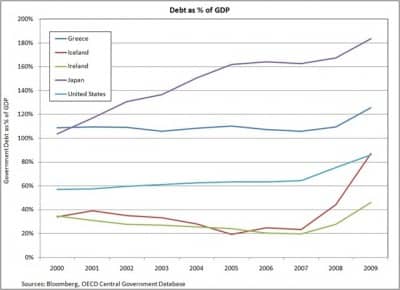The Camel’s Back
Ireland’s rating downgrade by Standard & Poor’s on August 24 and the related news of its struggling millstone, Anglo Irish Bank , bring our attention back to the ongoing challenges facing sovereign entities in the postdiluvian financial world of 2010. We are not alone in this endeavor, as the International Monetary Fund just published research on a similar theme. What can we learn from the current array of sovereign fiscal woes to better anticipate potential outcomes in the United States?
Let us state up front that while there are similarities between the U.S. and other problem countries, the differences are also profound. What happened in Ireland, Greece, Latvia, Iceland, Japan or any country experiencing the wrenching tribulations of fiscal imbalances, higher borrowing costs and/or reduced liquidity might not happen here. These countries do not print the world’s reserve currency. Nor are their currencies, unlike the US Dollar (or even the yen), viewed as a “safe haven” for investors. Moreover, the United States has a robust and diversified economy and the scale of deep capital markets that mitigate the risk of capital flight by foreign investors. In other words, the whole world is long and leveraged to the US, and that is a form of protection.
Nonetheless, the similarities are worthy of consideration. After all, the European Union is long and leveraged to Greece (and Spain and Portugal), and the UK is long and leveraged to Iceland. So these circumstances only prove that the potential collapse by a country will spur action by those most at risk, but the crisis can still occur. So what are some of the similar characteristics of countries that have faced financial crisis? Based on our high level review, the pre-existing conditions for sovereign financial difficulties include any combination of the following:
- rising debt-to-GDP and deficit-to-GDP ratios;
- significant asset price volatility;
- disproportionate amount of sovereign debt held externally;
- capital flight from foreign investors; and
- big swings in monetary growth.
Given the data, one could conclude that the U.S. is on a trajectory that has led others to misery. The following debt-to-GDP graph tells part of the story.
While these circumstances do not axiomatically result in debt crisis, they certainly create the environment in which it becomes a possibility. They are the straws on the camel’s back, if you will. In essence, deterioration in these economic indicators is necessary but not sufficient to cause a shift to crisis. These fears become realized when, given these pre-existing conditions, some unforeseeable tipping point or catalyzing event occurs. Tipping points are rarely predictable. In Greece, the tipping point came after the newly elected Papandreou government announced a sharp upward revision of the country’s deficit projections. Following the revelation, Fitch downgraded the country from A- to BBB+. A month later Standard & Poor’s and Moody’s adjusted their ratings as well. The actions taken by the rating agencies led investors to attack Greek bonds and drove up Greece’s cost to borrow.
In Ireland, the tipping point came with the global financial crisis. Credit tightening and the collapse of a housing bubble erased the gains of the Celtic Tiger years that saw Ireland rise to become one of the strongest European economies. Iceland’s tipping point came after a series of bad decisions by the government, including deregulation of the banking system. A credit bubble enabled by the country’s largest banks ensued, exacerbated by an over-reliance on foreign financing. Latvia’s troubles came when the euphoria of joining the European Union—and resulting inflows of foreign direct investment—led to rapid and unchecked economic growth and fiscal vulnerabilities. When global investors cut back their exposure to the Baltics, Latvia collapsed.
Back to Ireland for a moment. Switch a few names in the following sound bites, and it all sounds very familiar to American ears: In downgrading the Republic from AA to AA-, S&P said, “The projected fiscal cost to the Irish government of supporting the Irish financial sector has increased significantly above our prior estimates.” Landon Thomas of the New York Times in his piece on Anglo Irish said, “Even by the standards of the global banking collapse, Anglo Irish stood out. From a loan book of about 75 billion euros when the government took over in 2009, Anglo Irish says that it has only about 12 billion euros in loans that it classifies as performing. The bank is expected to transfer 36 billion euros in troubled loans to the [government] asset management agency — about half its existing loans.”
The tipping point into crisis may never come in the United States. But the red flags are there. In its research paper, the IMF warns that the U.S. is close to reaching its “debt limit”, the level at which bond investors don their vigilante hats. But there are exceptions. Japan’s massive domestic savings base enabled it to fund its imbalances, just as America has thus far been able to rely on global savings for its funding needs. But even these exceptions could have limits. Japan has an aging population that could eat into those savings, and global investors could well lose patience with American efforts to wrestle its fiscal problems under control. We’ll keep watching the American camel for signs of back strain.

Comments are closed.